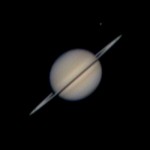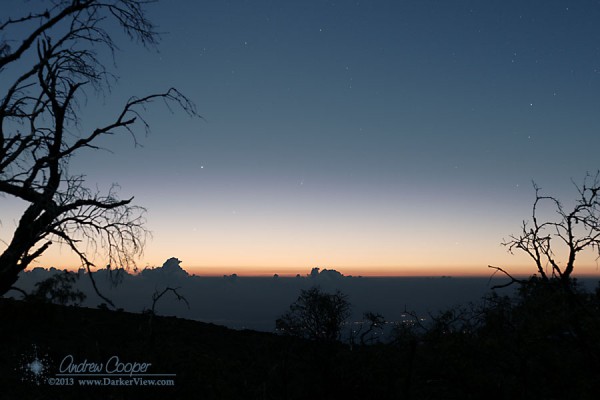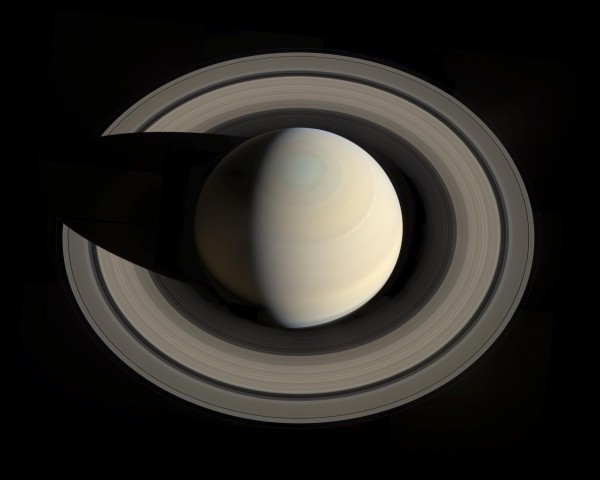Tomorrow’s dawn, January 6th, will see the Moon, Venus and Saturn in a nice conjunction. A beautiful 12% illuminated crescent Moon will be a bit over 4° above Venus shining brightly at -4 magnituide. Saturn will be another 3° below Venus. As an added accent the bright star Antares will be 6° south of the trio.
Tag: Saturn
The Moon and Saturn
There will be a close approach of the Moon and Saturn tonight and tomorrow. At sunset on the 9th the pair will be separated by less than 7° and found well up in the eastern sky. As the night progresses the pair will slowly close the gap. As the pair sets around 03:30 the morning of the 10th, the separation will have been reduced to about 4°. As the two rise on the evening of the 10th they will have passed and the separation will be increasing. At sunset the pair will be 7° apart.
Viewers on the other side of our planet will be able to observe the closest approach, much less than a degree for many, an occultation if you happen to be in the right place. Sky watchers in Capetown, South Africa will see the planet disappear behind the limb of the Moon for about an hour around 19:11UT.
The Moon and Saturn
Tonight the planet Saturn will be quite close to the Moon. The pair will rise about 18:20 HST and be well up in the east in the late evening. Look for 0.1 magnitude object just north of the Moon, there are no nearby stars bright enough to confuse for the planet. The Moon is full at 09:16HST tomorrow, just short of full for tonight’s pairing.
Observers in the islands will see the Moon pass less than 1° south of the planet during the early morning hours of the 14th. Observers in the southern hemisphere will be able to view an occultation if at the correct latitude, check a planetarium program for the view from your location.
Saturn at Opposition
Today the planet Saturn will pass through opposition, directly opposite the Sun in our sky.

During opposition the planet and rings will be slightly brighter than normal, an effect known as the opposition effect. The effect is most notable in the rings where the apparent brightness can increase by 30%. The effect is a combination of two factors, shadow hiding and the retro-reflective properties of the ring particles.
The Moon and Saturn
Tomorrow morning, Feb 21st, the Moon will be in close attendance with Saturn, separated by a little under 4°. The two will be high in southern the sky before dawn, a last quarter Moon will be 61% illuminated. Saturn can be seen as a 0.5 magnitude object just East of the Moon and west of the head of Scorpio. The following morning, Feb 22nd, the Moon will have moved to the other side of the ringed planet with a separation of just over 8°.
Viewers on the other side of the world will be able to see a very close pairing of the two, less than half a degree apart or even in occultaion depending on location. Close approach will be about 14:00 HST on the 21st. You could make an attempt to view the pair in the daytime sky, Saturn is bright enough to be seen next to the Moon in a modest telescope or even a good pair of binoculars. Unfortunately the Moon sets around 11:00, a few hours before close approach here in the islands.
ISON, Mercury and Saturn in the Dawn
Not quite the dramatic comet in the dawn shot I was hoping for. The comet is just barely able to compete with the dawn glow. Still, a beautiful morning.
Waiting to see what fate holds in store for this dirty snowball as it travels through the hell of the solar corona. I will try another photo session after perihelion.

Saturn at Superior Conjunction
Today at 01:29HST Saturn will pass through superior conjunction with the Sun. The planet will reappear in the dawn sky later in the month.
On the 23rd and 24th Saturn will be quite near the brightening comet C/2012 S1 ISON and the planet Mercury, creating an odd planet and comet conjunction. The trio will have about 5° separation. Even more odd, the comet 2p/Enke will be inside the triangle formed by the trio, probably at 7th magnitude.
Saturn from Above
A spectacular image of Saturn from above. Even better, the image was assembled by an amateur astronomer, Gordan Ugarkovic, working with Cassini imagery taken on October 10th. Click on the image to zoom in, then zoom in some more! You can see exquisite data in the polar cloud-tops and in the rings. Keep an eye out for the shepherd moons at the edges of the various rings…

The Moon and Saturn
Tonight will see a bright Moon just a few degrees from Saturn in the constellation Virgo. The Moon will be nearing full, about 94% illuminated and 4° south of Saturn.
Saturn at Opposition
Today the planet Saturn will pass through opposition, directly opposite the Sun in our sky. The planet will be well placed for observation all night long, rising at sunset, transiting at midnight, and setting at sunrise.
During opposition the planet and rings will be slightly brighter than normal, an effect known as the opposition effect. The effect is most notable in the rings where the apparent brightness can increase by 30%. The effect is a combination of two factors, shadow hiding and the retro-reflective properties of the ring particles.
